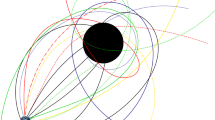Abstract
A new CUDA-C code for tracing orbits around non-charged black holes is presented. This code, named MALBEC, take advantage of the graphic processing units and the CUDA platform for tracking null and timelike test particles in Schwarzschild and Kerr. Also, a new general set of equations that describe the closed circular orbits of any timelike test particle in the equatorial plane is derived. These equations are extremely important in order to compare the analytical behavior of the orbits with the numerical results and verify the correct implementation of the Runge–Kutta algorithm in MALBEC. Finally, other numerical tests are performed, demonstrating that MALBEC is able to reproduce some well-known results in these metrics in a faster and more efficient way than a conventional CPU implementation.









Similar content being viewed by others
References
The LSC: Advanced ligo. Class. Quantum Grav. 32(7), 074001 (2015)
Sundararajan, P.A., Khanna, G., Hughes, S.: Binary black hole merger gravitational waves and recoil in the large mass ratio limit. Phys. Rev. D 81(10), 104009 (2010)
Chandrasekhar, S.: The Mathematical Theory of Black Holes, vol. 69. Oxford University Press, Oxford (1998)
Jefremov, P.I., Yu Tsupko, O., Bisnovatyi-Kogan, G.S.: Innermost stable circular orbits of spinning test particles in schwarzschild and kerr space-times. Phys. Rev. D 91(12), 124030 (2015)
Pugliese, D., Quevedo, H., Ruffini, R.: Motion of charged test particles in Reissner–Nordström spacetime. Phys. Rev. D 83(10), 104052 (2011)
Levin, J., Perez-Giz, G.: A periodic table for black hole orbits. Phys. Rev. D 77(10), 103005 (2008)
Fujita, R., Hikida, W.: Analytical solutions of bound timelike geodesic orbits in kerr spacetime. Class. Quantum Grav. 26(13), 135002 (2009)
Mino, Y.: Perturbative approach to an orbital evolution around a supermassive black hole. Phys. Rev. D 67(8), 084027 (2003)
Warburton, N., Barack, L., Sago, N.: Isofrequency pairing of geodesic orbits in kerr geometry. Phys. Rev. D 87(8), 084012 (2013)
Vincent, F.H., Paumard, T., Gourgoulhon, E., Perrin, G.: Gyoto: a new general relativistic ray-tracing code. Class. Quantum Grav 28(22), 225011 (2011)
Kuchelmeister, D., Müller, T., Ament, M., Wunner, G., Weiskopf, D.: Gpu-based four-dimensional general-relativistic ray tracing. Comput. Phys. Commun. 183(10), 2282–2290 (2012)
The Compute Unified Device Architecture CUDA. NVIDIA Corporation 2018. http://developer.nvidia.com
Gourgoulhon, E.: 3 + 1 Formalism in General Relativity: Bases of Numerical Relativity, vol. 846. Springer, Berlin (2012)
York Jr., J.W.: Kinematics and dynamics of general relativity. In: Smarr, L.L. (ed.) Sources of Gravitational Radiation, pp. 83–126. Cambridge University Press, Cambridge (1979)
van Holten, J.W.: Gravitational waves and black holes. Fortschr. Phys. 45, 439–516 (1997)
Poisson, E.: A Relativist’s Toolkit: The Mathematics of Black-hole Mechanics. Cambridge University Press, Cambridge (2004)
Bardeen, J.M., Press, W.H., Teukolsky, S.A.: Rotating black holes: locally nonrotating frames, energy extraction, and scalar synchrotron radiation. Astrophys. J. 178, 347–370 (1972)
Nvidia, C.U.D.A.: Nvidia cuda c programming guide. Nvidia Corp. 120(18), 8 (2011)
Butcher, J.C.: Numerical Methods for Ordinary Differential Equations, 2nd edn. Wiley, Chichester (2008)
CUDA-C Best practice guide. NVIDIA Corporation 2018. http://docs.nvidia.com/cuda/cuda-c-best-practices-guide/index.html
Acknowledgements
The author would like to thank to Dr. Omar Ortiz for his suggestions concerning the convergence test.
Author information
Authors and Affiliations
Corresponding author
Rights and permissions
About this article
Cite this article
Quiroga, G.D. MALBEC: a new CUDA-C ray-tracer in general relativity. Gen Relativ Gravit 50, 75 (2018). https://doi.org/10.1007/s10714-018-2387-z
Received:
Accepted:
Published:
DOI: https://doi.org/10.1007/s10714-018-2387-z




